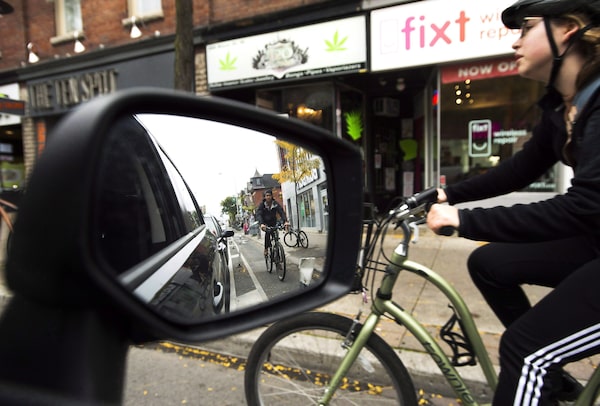
Cyclists ride on designated Bloor Street bike lanes in Toronto in 2017.Nathan Denette/The Canadian Press
People who drive cars on public roads must pass mandatory tests and get a licence to prove they know the rules of the road. So doesn’t it make sense for cyclists to have to pass mandatory tests and get a licence too? We hear a lot about the dangers of cycling, so wouldn’t this make things safer for everybody? — Colin, Toronto
Toronto abolished bicycle licences in the 1950s. Calls to bring them back have been rejected.
“It’s been examined here in Toronto and in other jurisdictions and in our view it’s not a good use of time and money,” said Sarah Bradley, spokeswoman for Cycle Toronto. “It’s costly to introduce and enforce and hasn’t been proven to lead to behaviour change.”
In 1957, Toronto stopped requiring bikes to have licence plates — which had cost 50 cents a year and came with an annual bike inspection at a police station (but no written test).
The bylaw amendment ending licensing, signed by then-mayor Nathan Phillips, said licence requirements “often results in an unconscious contravention of the law at a very tender age. They also emphasize the resulting poor public relations between police officers and children.”
Today, cyclists have to follow the rules of the road – and pay the same fines – as drivers. And that’s without special licences or plates.
“There are some cyclists who abuse the rules of the road and ride recklessly in and out of traffic, but the same can also be said about some driving motor vehicles,” said Andy Wilson, national program manager for Can-Bike, Cycling Canada’s education program. “Are we going to require someone as young as three years of age… who can ride a two-wheeled bicycle to get a licence?”
Even if exemptions were made for kids, licensing schemes – whether they involve licences for individual cyclists or for the bikes themselves – are often considered to be money-losers. In 2011, Ottawa rejected a call to license 750,000 bikes to try to reduce thefts because officials estimated it would cost $100,000 a year to operate but bring in only $40,000 a year in revenue. The city also said that licensing could discourage people from riding their bikes, which could ultimately mean more people driving instead. That could make congestion worse.
Cycling groups say education is important. But it would be tough to enforce a rule that required all cyclists to have passed a test, they said.
“What may be better is to have a stronger component [of cycling safety] in the driver education curriculum,” Bradley said.
Education not enough?
On Toronto streets so far this year, three cyclists have been killed, Toronto police said. Last year, there were four deaths.
“In order to reduce and even eliminate these deaths and serious injuries we know what we need because there’s robust evidence – and that’s lower speed limits and separated bike lanes,” said Dr. Samantha Green, a Toronto family doctor and co-founder of Doctors for Safe Cycling. “We know it’s that simple. It’s not public education that will solve this problem.”
The group wants candidates in the upcoming Toronto election to commit to stalled plans to build a network of physically-separated bike lanes throughout the city.
“Mayor Tory is very proud of Vision Zero, but it’s obviously not working,” Green said.
In a 2011 position paper, the Ontario Medical Association recommended changes that could improve cyclist safety, including making bike lane and bike path networks “safe and seamless enough for parents to feel comfortable permitting their children to ride on them,” adding a section on “vehicle-bicycle interactions” to the Ontario driver’s test and making bicycle education mandatory in elementary schools.
While critics of pilots to close lanes of traffic to make room for cyclists or streetcars have called such projects a “war on the car,” an August poll showed 75 percent support for physically-separated bike lanes from people who rely on their cars to get around.
And even with bike lanes, crashes still happen because drivers go too fast – and they might not realize that they have to look out for cyclists before turning, said Cycle Toronto’s Bradley.
“A woman was hit and killed in a bike lane, so even with a protected bike lane there’s still a risk,” she said. “That’s why we need to build a grid of [lanes], so people driving know what to expect.”
Have a driving question? Send it to globedrive@globeandmail.com. Canada’s a big place, so let us know where you are so we can find the answer for your city and province.
Sign up for the weekly Drive newsletter, delivered to your inbox for free. Follow us on Instagram, @globedrive.